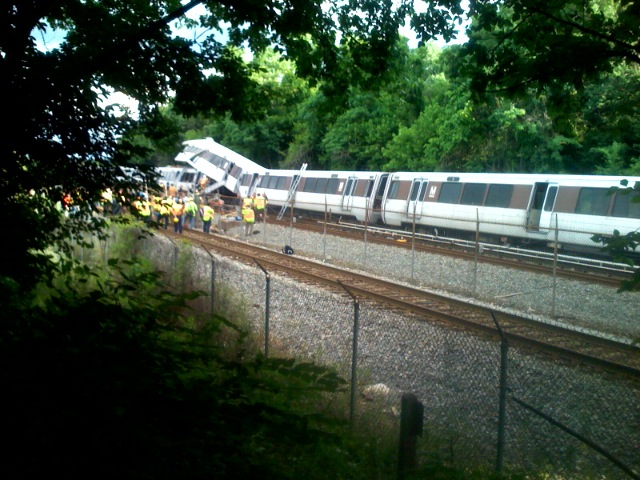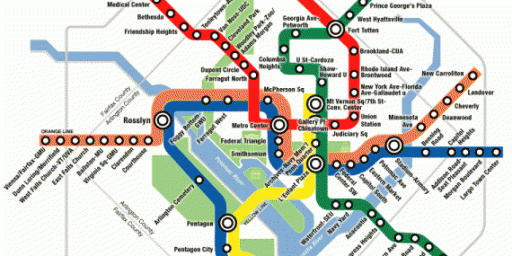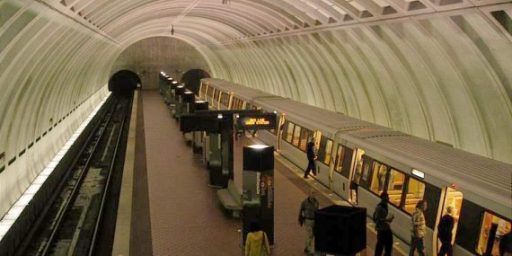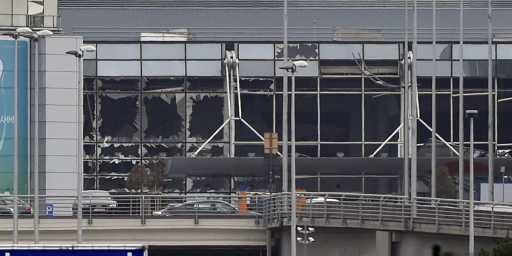Metro Crash Politics
 I agree with Matt Yglesias that “it’s a bit ugly to talk politics in the wake of a tragedy” but, like him, I will nonetheless point to a couple of interesting, related debates that have been sparked by yesterday’s crash on DC’s Metrorail system Red Line.
I agree with Matt Yglesias that “it’s a bit ugly to talk politics in the wake of a tragedy” but, like him, I will nonetheless point to a couple of interesting, related debates that have been sparked by yesterday’s crash on DC’s Metrorail system Red Line.
This report, naturally, is causing some finger pointing:
The subway train that plowed into another, causing a crash that killed seven and injured scores of others in the nation’s capital, was part of an aging fleet that federal regulators had recommended three years ago be phased out or retrofitted, a safety investigator said Tuesday. Debbie Hersman of the National Transportation Safety Board said the Metrorail transit system “was not able to do what we asked them to do.”
Glenn Reynolds quips that, “If this hapened in the private sector, we’d be hearing about ‘greed.'” That’s probably true. The fact of the matter, though, is that, prior to yesterday’s tragedy, there had been precisely one fatal crash on Metro, a 1982 derailment that killed three. And Metro spokesmen said that they were in fact responding the the 2006 NTSB finding and have new trains on order.
But, as in the private sector, replacing potentially dangerous equipment can be expensive and cash might not be available to do everything right away. In both cases, someone has to pay for it. In Metro’s case, that means some combination of 1) the paying customers, 2) DC-Virginia-Maryland governments who maintain the system and have an interest in getting people off the roads, and 3) Congress.
As James Ridgeway notes, Sen. Tom Coburn has been almost singlehandedly blocking a $1.5 billion investment in upgrading the system, arguing that those who directly benefit from the system should pay the cost, not taxpayers in Oklahoma. That’s a view that I’m largely sympathetic to.
But the practical problems are manifold. First, increasing rider fees substantially will reduce ridership considerably. Not only could that make it harder to raise the funds to upgrade the system, but it increases the strain on already unmanageable local road traffic. Second, most Metrorail riders are commuters who are outside the ability of DC’s uniquely non-independent city government to tax. Third, because DC is the national capital, it is in some ways the country’s city almost as much as it is the local residents’.
My guess is that the tragic crash will make it politically impossible for Congress not to pony up emergency repair money. That’s probably an irrational response to a freak occurrence. But, often, that’s how legislation gets passed.
UPDATE: And, no, a metropolitan subway system is not the equivalent of any other business that should be expected to sustain itself through profits. It’s part of the transportation infrastructure just like roads, regular rail, airports, seaports, and so forth. The “competition” for Metro is publicly financed highways.
Photo credit: David Corn.






Coburn has a point-but then taxpayers in one state pay for improvements and other pork in other states. I understand the taxpayers from all over the US helped build an airport that has Murtha’s name on it.
My feeling though is that the states that are most impacted by the use of the metro system and the DC government need to pony up the majority of expenses for this one.
Your kind of skipping over the fact that were it a private sector venture, the system would either have to price the fares so that capital was generated to fund the upgrades or cease to run. If the ridership wasn’t there at a price to continue as an ongoing enterprise then so be it.
Local governments who benefit from the system could provide subsidies but there wouldn’t be an ability to take from people who will never see benefit from the system. The system already receives a lot of cash from Oklahoma via the federal government’s program to pay employees to use the train. I’ll be the federal employee in Oklahoma City doesn’t get an extra $1200 a year to come to work?
Like the bailouts, for example.
You know it strikes me as reasonable to suggest that the ‘comment’ from the NTSB’s Hersman itself should be considered a political pointmaker.
That aside, reports I’m hearing second hand, now, suggest that the trailing train of the two involved had stopped, telling passegngers that they were waiting for the traffic to clear at the Ft Totten station ahead. After pausing for a few, it then accelerated, under the NewHampsire Ave Bridge, which as I say is a bit of a turn, into the first train, which was just beyond the New Hampshire ave bridge. Since the train that was struck was well short of Ft Totten as well, one possibility is the op of the trailing train thought she’d been talked by a stop, and given clearence into Ft Totten. I don’t know if the first train actually had a train in front of it at Ft Totten.
I gather that the trailing train was an older, 1000 unit, which among other things doesn’t have the ‘flight recorder’ on it. whereas the train that got hit does have one. I’m trying just now to nail down if the 1000 series has the brake to track signal interlocks that would have prevented the accident… like the newer ones do. I don’t know yet.
Just realized. What’s the deal with the NTSB doing politics now? They haven’t even begun to get close to a cause determination and the NTSB PR hack is speculating about upgrade recommendations.
First off, the older cars were apparently completely acceptable at some time so the question would be, Did Metro start operating their system in a way that didn’t compensate for the older cars as they obviously compensated when they were state of the art.
Secondly, if the older cars were such a safety risk why didn’t NTSB or whomever controls subway safety standards decertify them for use? Rather then recommending they be phased out.
Thirdly, the report I read was that the older cars were in the train that hit the train of newer cars so a tendency to rollback wouldn’t have been a factor.
Again, why is the investigating agency speculating before they’ve even had a chance to collect all the recorders. Obviously, the NTSB is now trying to create an environment where Metro can do some rent seeking. So the question is, why is the NTSB doing lobbying for the Metro?
Correct. But what other variables the older fleet brings to the table, if any aside from the lack of a flight recorder, I don’t know as yet.
Trains suffer from being political icons, for the right and the left, and so any practical issue always becomes an ideological scrum.
It would be nice to use them (a) where they pay for themselves, or (b) where citizens want to reduce auto congestion, but it’s not that simple is it?
Except that it is a public good. One could argue that taxpayers in and around DC should pay vs. taxpayers in Oklahoma, but then I guess you could also point out that DC is not a state and is under the federal government…and lots of tourists (probably even ones from Oklahoma) ride the metro and make it far less useful to locals at various times of the year.
And anyone who thinks that a public good, generally, can be run profitably should consider re-reading the definition of a public good.
OK.. Apparently, the 2000 series of power cars, and up on that system , did get advanced automatic train control. How automatic the train control on the 1000’s was, I dunno yet. My guess is minimal ATC if any. Which suggests the operator of the rear train was on full manual control. If all this is accurate… and I’ve not confimed much of it yet, it would explain quite a bit.
The 1000’s were delivered in 76. refurned in 92, The next gen, the 2000’s del in 82, refruned in 03 and 04. Other series are more recent.
Sorry if I’ve missed anything guys.. I tried.
Nice work Eric!
Eric, the 1000-series cars at fully automatic positive control, just like all the other cars, and just like BART, which predates Metro by five years. The control technology is similar.
Jeff;
Interesting.
The list I obtained earlier today doesn’t make that point clear. Nor, interestingly does the Wiki on the point. Thanks.
PS; is it possible that the ATC wasn’t originally supplied in the first build, but supplied in the refirb in 92? That might explain the discrepancy I’m seeing.
I wonder if the citizens of Oklahoma get more federal dollars than they pay out and, if so, would the good senator find that unfair…
Technically, its the same principle so using Coburn-LogicTM they should take a hair cut in federal spending, or get a special Oklahoma income tax surcharge.
Just got home a short while ago, and caught an email that didn’t make it to my phone. Two things come to light now from this contact;
1: The rear train was in fact equipped with auto train control, and the system was on full auto at the time of the crash.
2: The Mushroom, contrary to some reports, was depressed, though when exactly it had been pressed is at question; Was it pressed prior to impact, or by stuff flying around the cab in the impact itself.
The idea then, of a missed communication, appears to be overridden by these new facts. At least to some degree, the motorman on the trailing train would appear to have done it right, for the most part, or all the way, depending on what you believe about the mushroom and when it was hit.
The only chance to my mind for that not to have been true as if she somehow overrode the automation. The consensus of reporting I’m seeing suggests that the motorman in the second train only had about three months on the job. That being true, she may have had some instantaneous confusion over the controls and hit the wrong one, when the emergency arose. I will not speculate as to the chances of that being true, I merely suggest that the possibility exists, based on the information I have at the moment. Which, as I say, is second hand in nature for the most part.
If it’s not true, and the motorman did everything correctly, the resulting CYA festival from the city and the federal government, and the various unions, all of them involved with the Metro, will be running for the next year at least.
Complicating this forensic activity is the lack of a black box in the second train. Without it, we may never know the answer to whether not the motorman attempted to apply the emergency mushroom.
Interestingly, one of the reporters on Fox radio tonight suggested that investigators “do not believe they will find a black box for the second train.” You can imagine my ears perked a little at that, since I had already heard by way of my contacts in DC the 1000’s do not have them. Perhaps that’s just a poor choice of words on Fox’s part, or perhaps my contacts were partially in error there, since the Fox wording suggests that it’s possible that the earlier models were retrofitted with them…but it does suggest the amount of confusion coming from the reports down there as to the equipment on the 1000 series in particular.
For clarity, let me say that the contacts I have there are railfans, and tend to focus on freight trains for the most part… (Photos, mostly) The subway system is something of a second-line hobby of theirs since they happen live in the DC area. I’m going to owe them a dinner, the next time I’m down that way, I’ve been hammering them for info like that most of the day… and such info is, you’ll admit, pretty vertical in nature… Very few who don’t make a living on the system, no these kind of “inside baseball” details. I certainly didn’t know most of it.
Thanks, Brian. Just a knot I had to untie to the extent I could. I did background work like that for the news dept of a station I used to work for years ago, and found I rather liked doing it. The web has made this process a lot faster, but I’m not sure if it’s made it easier.
Interesting thread. thanks for the post James.
I wonder how the city should feel about the $611 Million it spent on a new baseball stadium instead of chipping in for upgrades (irrespective of the NTSB politics)? How many Nationals wins for the price of human life and the fear that now prevails on the metro system?
Mukul;
It seems a bit premature to tag this has an upgrade issue . I’m the last one to defend government agency , God knows, the but in fairness I’m forced to say that we have no way of knowing if the upgrade issue was at all involved with the accident happening in the first place and whether or not one of the more recent models of car would have caused last death and injury, once it did happen.
All;
One more point while I have the editor open. The position of the rail cars following the accident doesn’t surprise me much it all. I’ve seen a number of rail accidents over the years being a railfan myself, and a train being rear ended usually results in local mode of ending up sitting on top of the last car or two that’s been hit from behind. There was an accident on Toronto’s TTC like that several years ago, And one about 100 miles east of me here at Syracuse where an Amtrak locomotive ended up mostly inside a gondola with only minor injuries all around on that occasion.
To solve that problem, freight engines have for about the last decade been sprouting what are called “anti climber devices”. Essentially, the device is a thick, heavy, and relatively flat, piece of steel mounted to the frame rails of the locomotive in a horizontal fashion across the front and rear. The object of the device is to keep the front of the locomotive on the ground by forcing this apparatus under the knuckle , which is the part that attaches to the remainder of the train. Without the anti climber, you can be pretty much assured that the power is going up over the top of the last car… being the path of least resistance. With the anti climber, the energy of the collision is forced into a more lateral fashion, generally pushing the offending locomotive to the right or to the left depending.
I am convinced that we will now see some chatter about why anti-climbers aren’t being used in a subway environment, given their successes elsewhere. The trouble, of course, is that the hitching arrangement, and in fact most of the subway car design, does not adapt well to this device and would most likely require significant redesign of both the car and the device to work well.
Before someone starts, it’s also fairly obvious that in tunnels, there is not whole bunch of space left or right to push anyway , but at least it would have distributed the energy a little more evenly thus possibly saving lives.
What the solution is for all of that I’ve no idea,sor of a com-plete redesign of all the rail cars on the system… but all I’m saying is the subject’s going to come up over the next few weeks.
Very heavily agree with your post. It reminds me why you are the only conservative blogger I read.